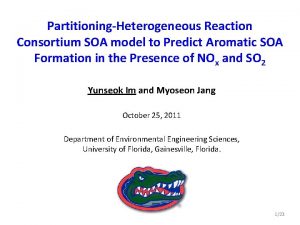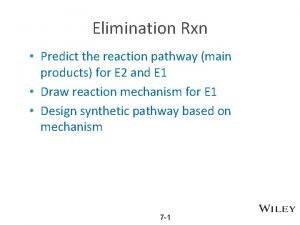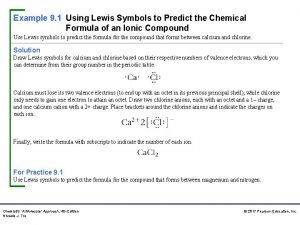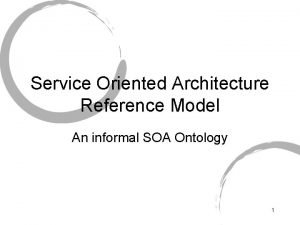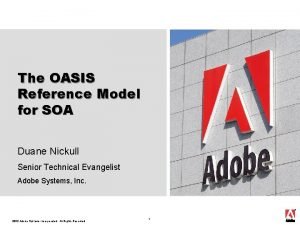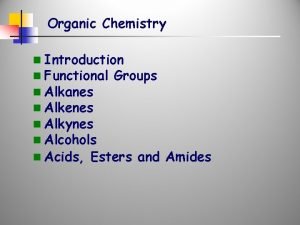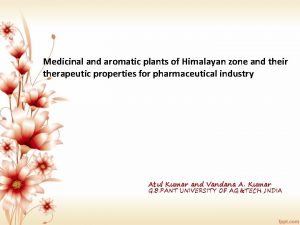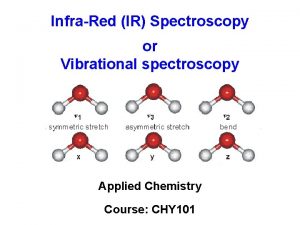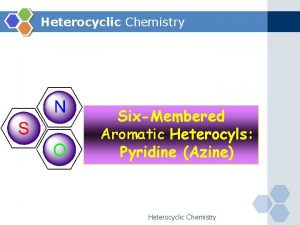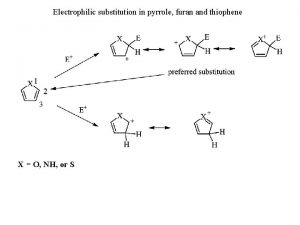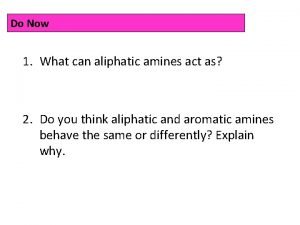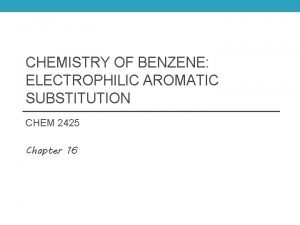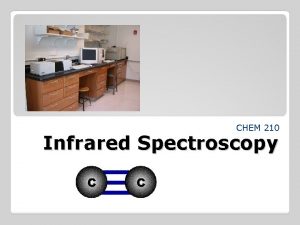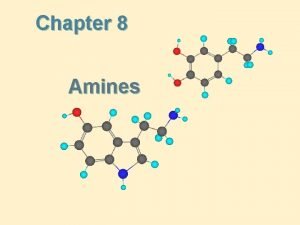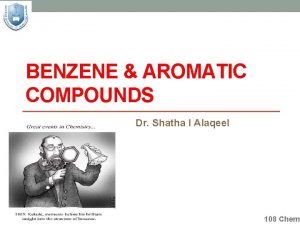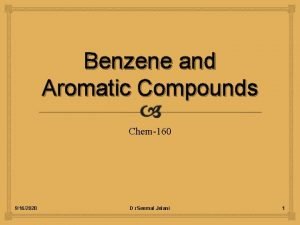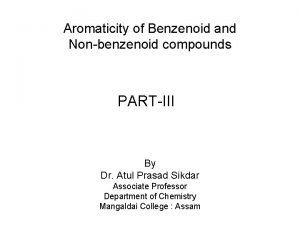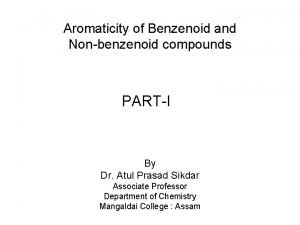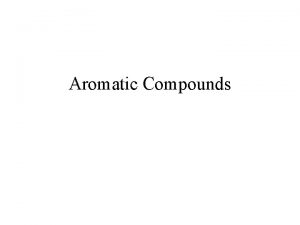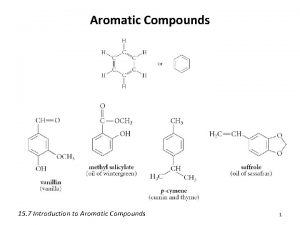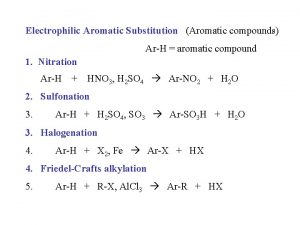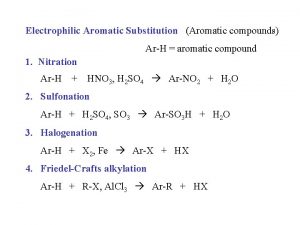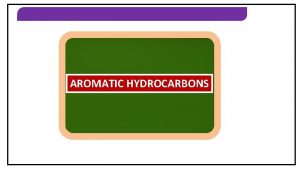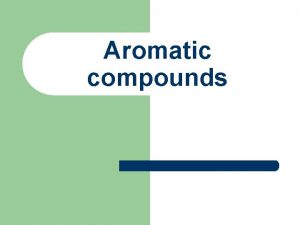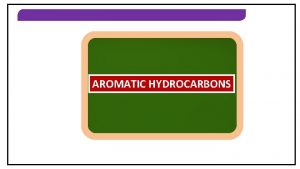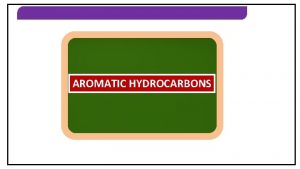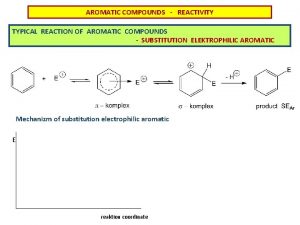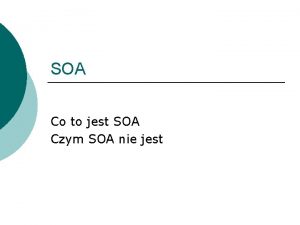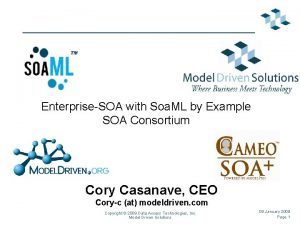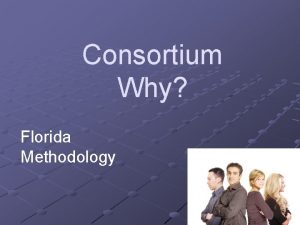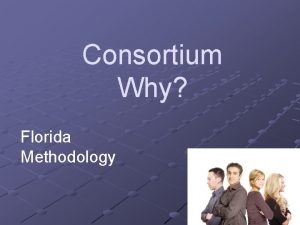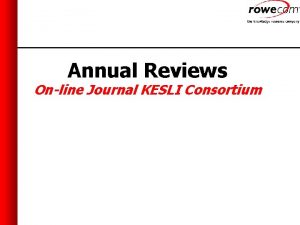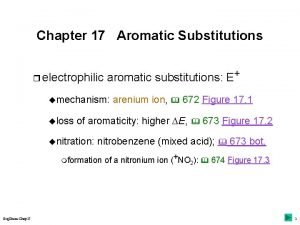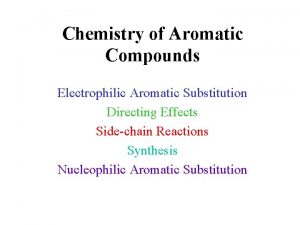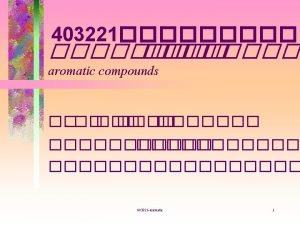PartitioningHeterogeneous Reaction Consortium SOA model to Predict Aromatic






















- Slides: 22

Partitioning-Heterogeneous Reaction Consortium SOA model to Predict Aromatic SOA Formation in the Presence of NOx and SO 2 Yunseok Im and Myoseon Jang October 25, 2011 Department of Environmental Engineering Sciences, University of Florida, Gainesville, Florida. 1/23

Introduction Secondary Organic Aerosol (SOA) SOA is formed by accommodation of organic compounds which are created from either atmospheric oxidation reactions associated with photochemical NOx cycles in the gas phase or particle phase heterogeneous reactions SO 2 ---> H 2 SO 4 Heterogeneous Preexisting Kp reactions Acidic NH 3 Inorganics Ø SOA is major component of atmospheric carbon (20~90% of Total organic Carbon) 2/23

Aromatic hydrocarbons Ø Aromatics are major anthropogenic VOCs in urban area. Ø Source: Motor vehicles, Solvent use, Biomass burning (20% of VOC emission from gasoline, Schauer et al, ES&T, 2002) Ø Concentration ranges of toluene in urban air : 2 -39 ppb (Finlayson-Pitts and Pitts, 2000) Toluene Xylene 3/23

Motivation Current SOA models (partitioning model) Under-predict the field observed SOA mass There are something more than partitioning process. Aerosol phase chemistry (Heterogeneous RXN) Oligomerization / Acid-catalyzed-heterogeneous RXN Effect of SO 2 on SOA formation (Aromatics) (SO 2 oxidation) 4/23

PHRCSOA model (Partitioning-Heterogeneous Reaction Consortium SOA model) 5/23

PHRCSOA Model Structure PHRCSOA (Partitioning-Heterogeneous Reaction Consortium SOA )model Model structure RH + Ox ox, 1 Pox, 1 + ox, 2 Pox, 2 + …+ ox, 20 Pox, 20 s a G l o os r e A Gas phase reaction products ij: Stoichiometric coefficient for product groups Lumping of products OMH Heterogeneous reaction SOA mass OMAC Acid-catalysis Ø MCM Ø MORPHO OMP Partitioning SOA mass OMolg Oligomerization OMT Total Aerosol Mass OMT = OMP + OMH 6/23

Example of Toluene oxidation of MCM • 776 reactions • 147 toluene oxygenated products 7/23 http: //mcm. leeds. ac. uk/MCM/browse. htt? species=TOLUENE

Lumping based on vapor pressure and reactivity Ø Five different vapor pressure groups i= 1 (10 -6 mm. Hg) i= 2 (10 -5 mm. Hg) i= 3 (10 -4 mm. Hg) i= 4 (10 -3 mm. Hg) i= 5 (10 -2 mm. Hg) Ø Heterogeneous Reactivity (Fast, Medium, Slow, Partitioning only) i = 1, j = H-f i = 1, j = H-m i = 1, j = H-s i = 1, j = PO 8/23 Cao and Jang, ES&T, 2009

147 PRODUCTS 20 LUMPING GROUPS Toluene + Ox ox, 1 Pox, 1 + ox, 2 Pox, 2 + …+ ox, 20 Pox, 20 Slow Reactivity High Reactivity Less Volatile Vapor Pressure (mm. Hg) i=1 (10 -2) i=2 (10 -3) i=3 (10 -4) i=4 (10 -5) Very Volatile i=5 (10 -6) H-f H-m H-s H-PO (Fast) (Medium) (Slow) (Partitioning Only) α 1, f α 2, f α 3, f α 4, f α 5, f α 1, m α 2, m α 3, m α 4, m α 5, m α 1, s α 2, s α 3, s α 4, s α 5, s α 1, PO α 2, PO α 3, PO α 4, PO α 5, PO 9/23

The Effect of NOx on SOA formation NOx = 150 ppb g) tiv ac Vapor pres sure (mm. H g) Re sure (mm. H Re Vapor pres ac tiv ity NOx = 30 ppb 10/23

The Effect of NOx on SOA formation Ø Gas kinetic model (MCM) simulation at various NOx (10 -350 ppb) Lumping i j α = f (NOx) α 1, F 0 α 4, F 2. 4111 x 2 - 0. 1293 x + 0. 0019 α 1, M -784. 41 x 3 + 56. 704 x 2 - 1. 3875 x + 0. 0172 α 4, M 5952. 6 x 3 - 387. 47 x 2 + 6. 3498 x + 0. 0289 i= 1 i= 4 α 1, S 0 α 4, S -10021 x 3 + 663. 49 x 2 - 15. 313 x + 0. 2143 2 α 1, P 6677. 8 x 3 - 451. 6 x 2 + 8. 0669 x + 0. 0162 α α 4, s 4, P -20. 733 x + 0. 7243 x + 0. 026 α 2, F 0 α 5, F 25062 x 3 - 1682. 7 x 2 + 34. 584 x + 0. 1777 α 2, M 0 α 4, M α 5 M 24872 x 3 - 1648. 6 x 2 + 32. 532 x + 0. 2432 i= 5 α 2, S 867. 26 x 3 - 46. 81 x 2 + 0. 3279 x + 0. 0099 α 5, S 20500 x 3 - 1337. 1 x 2 + 26. 141 x + 0. 2188 α 2, P 0 α 5, P -14972 x 3 + 1011. 2 x 2 - 18. 723 x + 0. 2254 α 4, P α 3, F 6319. 5 x 3 - 424. 58 x 2 + 7. 563 x - 0. 0003 α 3 M 1105. 7 x 3 - 68. 122 x 2 + 0. 7903 x + 0. 0177 i= 3 α 3, S -401. 87 x 3 + 43. 206 x 2 - 1. 5424 x + 0. 0197 α 3, P -49651 x 3 + 3283. 3 x 2 - 65. 29 x + 0. 4762 11/23

PHRCSOA Model Structure Model structure RH + Ox ox, 1 Pox, 1 + ox, 2 Pox, 2 + …+ ox, 20 Pox, 20 Gas phase reaction products ij: Stoichiometric coefficient for product groups Lumping of products OMH Heterogeneous reaction SOA mass OMAC Acid-catalysis OMp Partitioning SOA mass OMolg Oligomerization OMT Total Aerosol Mass OMT = OMP + OMH 12/23

SOA Model Concept GAS PHASE Gas kinetic model (MCM) SO 2 oxidation H 2 SO 4 20 product lumping groups Cgas KP Partitioning ORGANIC PHASE CP (OMP) INORGANIC PHASE Solubil Non Acid-Catalyzed Heterogeneous Oligomerization l Phase separation (organic vs. Inorganic) ü Inorganic phase – Acid-catalyzed RXN ü Organic phase – Oligomerization Cin ity OMH (Non-volatile) 13/23

Model Equations Modification of the mass balance equation used in CMAQ Schell et al. , JGR, 2001 Acid-catalysis Oligomerization Excess acidity Inorganic thermodynamics Basicity of organics lumping parameter 14/23

Chamber experiments 52 + 52 = 104 m 3 UF Atmospheric Photochemical Outdoor Reactor (UF-APHOR) dual chambers Toluene, P-Xylene (200 ppb) NOx (30 ppb) With/ without SO 2 (80 ppb) 15/23

Toluene Gas phase simulation vs. Exp. Without SO 2 Toluene O 3 Temp: 16 – 42 o. C RH : 10 – 33 % NOx With SO 2 Toluene SO 2 NOx Ø Reasonably prediction O 3 ü Toluene decay ü O 3 formation ü NOx chemistry Ø Artificial OH radical : 2. 0 E+8 molecules cm-3 s-1 Bloss et al : 4. 0 E+8 Cao et al: 4. 0 E+8 16/23

Toluene SOA simulation vs. Exp. Without SO 2 Exp. OMT Ø Yield increase : 20~40% OMP OMH Exp. With SO 2 OMT OMP OMH 17/23

Without SO 2 P-xylene Gas phase simulation vs. Exp. P-Xylene O 3 Temp: 14 – 41 o. C RH : 9 – 35 % NOx With SO 2 P-Xylene Ø O 3 under-prediction O 3 Ø Artificial OH radical : 1. 7 E+8 molecules cm-3 s-1 SO 2 NOx 18/23

P-Xylene SOA simulation vs. Exp. Without SO 2 Exp. Ø Yield increase : 20~40% OMT OMP OMH With SO 2 Exp. OMT OMP OMH 19/23

Conclusion q The model reasonably predicts the Experiments for Aromatics v Gas kinetics : MCM v SOA formation : PHRCSOA model. q In the presence of SO 2, 30 % yield increase for SOA from Toluene and P-xylene. Uncertainty of Model q Accuracy of gas product prediction of MCM q Solubility calculation of organic compounds on inorganic phase (inorganic phase was assumed as water) 20/23

Future Work - Model evaluation for other individual SOA precursors. and the Mixtures of VOCs. - Application to the regional Air quality Model, CMAQ SOA module (partitioning and Heterogeneous OM) 21/23

Thank you 22/23
 1pox1
1pox1 Predict the products of the elimination reaction.
Predict the products of the elimination reaction. Ocn- resonance structures
Ocn- resonance structures Soa reference model
Soa reference model Soa reference model
Soa reference model Soa reference model
Soa reference model Alkane functional group
Alkane functional group Define medicinal plants
Define medicinal plants Asva arista
Asva arista Aromatic ring ir spectrum
Aromatic ring ir spectrum Bonnemann cyclization reaction
Bonnemann cyclization reaction Nucleophilic substitution reaction of pyrrole
Nucleophilic substitution reaction of pyrrole Amines chemsheets
Amines chemsheets Friedel crafts alkylation limitations
Friedel crafts alkylation limitations 1-octyne ir spectrum
1-octyne ir spectrum Aliphatic amines and aromatic amines
Aliphatic amines and aromatic amines Cycloheptatrienyl cation
Cycloheptatrienyl cation Examples of non aromatic compounds
Examples of non aromatic compounds Benzene bond length
Benzene bond length Non aromatic heterocyclic compounds
Non aromatic heterocyclic compounds What is n in huckel rule
What is n in huckel rule Which of the following compounds is aromatic?
Which of the following compounds is aromatic? Classify the following molecule
Classify the following molecule
